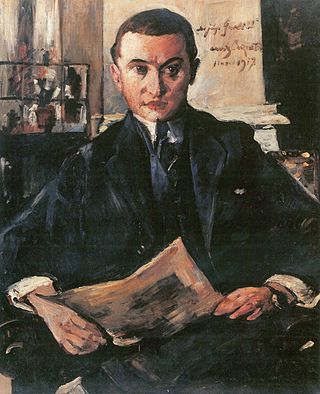
Degenerate art was a term adopted in the 1920s by the Nazi Party in Germany to describe modern art. During the dictatorship of Adolf Hitler, German modernist art, including many works of internationally renowned artists, was removed from state-owned museums and banned in Nazi Germany on the grounds that such art was an "insult to German feeling", un-German, Freemasonic, Jewish, or Communist in nature. Those identified as degenerate artists were subjected to sanctions that included being dismissed from teaching positions, being forbidden to exhibit or to sell their art, and in some cases being forbidden to produce art.

Otto Müller was a German painter and printmaker of the Die Brücke expressionist movement.

Nazi plunder was organized stealing of art and other items which occurred as a result of the organized looting of European countries during the time of the Nazi Party in Germany.

The Lentos Art Museum is a museum of modern art in Linz, Austria, which opened in May 2003 as the successor to the Neue Galerie der Stadt Linz.

Wolfgang Gurlitt was a German art dealer, museum director and publisher whose art collection included Nazi-looted art.
Art theft and looting occurred on a massive scale during World War II. It originated with the policies of the Axis countries, primarily Nazi Germany and Japan, which systematically looted occupied territories. Near the end of the war the Soviet Union, in turn, began looting reclaimed and occupied territories. "The grand scale of looted artwork by the Nazis has resulted in the loss of many pieces being scattered across the world."
Kunstschutz is the German term for the principle of preserving cultural heritage and artworks during armed conflict, especially during the first and second world wars, with the stated aim of protecting the enemy's art and returning after the end of hostilities. It is associated with the image of the "art officer" (Kunstoffizier) or "art expert" (Kunstsachverständiger).
Curt Valentin was a German-Jewish art dealer known for handling modern art, particularly sculpture, and works classified as "degenerate", seized from public museums or looted from private collectors by the Nazi regime in Germany.

The Degenerate Art exhibition was an art exhibition organized by Adolf Ziegler and the Nazi Party in Munich from 19 July to 30 November 1937. The exhibition presented 650 works of art, confiscated from German museums, and was staged in counterpoint to the concurrent Great German Art Exhibition. The day before the exhibition started, Adolf Hitler delivered a speech declaring "merciless war" on cultural disintegration, attacking "chatterboxes, dilettantes and art swindlers". Degenerate art was defined as works that "insult German feeling, or destroy or confuse natural form or simply reveal an absence of adequate manual and artistic skill". One million people attended the exhibition in its first six weeks. A U.S. critic commented, "There are probably plenty of people—art lovers—in Boston, who will side with Hitler in this particular purge". This particular take is controversial, however, given the greater political context of the exhibition.

Hildebrand Gurlitt was a German art historian and art gallery director who dealt in Nazi-looted art as one of Hitler's and Goering's four authorized dealers for "degenerate art".

The Gurlitt Collection was a collection of around 1,500 art works assembled by Cornelius Gurlitt, the son of one of Hitler's official art dealers, Hildebrand Gurlitt (1895–1956), and which was found to have contained several artworks looted from Jews by the Nazis.

Rolf Nikolaus Cornelius Gurlitt was a German art collector. The son of Hildebrand Gurlitt, a Nazi-era dealer of looted art, Gurlitt was discovered to have concealed a stash of artworks known as the Gurlitt trove or Gurlitt Collection, several of which have been proven to have been looted from Jews by Nazis.
The Koordinierungsstelle für Kulturgutverluste, also known as the Koordinierungsstelle Magdeburg, is an institution of the German federal and state governments at the Saxony-Anhalt Ministry of Culture and is the central German institution for the documentation of lost and found cultural assets looted by the Nazis. Established in 2001, the Koordinierungsstelle's Lost Art Database documents and publishes lost and found reports by institutions and private individuals. It operates on a cooperative basis with the international Art Loss Register.

Friedrich "Fritz" Gurlitt, originally from Vienna, was a Berlin based art dealer and collector, specialising, in particular, in contemporary art. After his early death the art gallery he had established in central Berlin was taken on by his son, the dealer Wolfgang Gurlitt (1888-1965).

Monika Grütters is a German politician of the Christian Democratic Union (CDU) who served as Federal Government Commissioner for Culture and the Media in the government of Chancellor Angela Merkel from 2013-2021. She has been a member of the German Bundestag since 2005 and was chairwoman of the Committee on Culture and Media Affairs from 2009 to 2013. Since December 2016, Grütters has also been the chairwoman of the CDU Berlin and an elected member of the CDU Federal Executive Board.
Karl Buchholz was one of Hitler's Nazi art dealers specialized in selling looted "Degenerate Art".
Hermann Voss was a German art historian and museum director appointed by Hitler to acquire art, much of it looted by Nazis, for Hitler's planned Führermuseum in Linz, Austria.

Katja Terlau is a German art historian and provenance researcher. She was a co-initiator and founding member of the international Arbeitskreis Provenienzforschung in Germany, founded in 2000 and is considered a pioneer of German Provenance Research, which she entered after the Washington Principles on Nazi-Confiscated Art of 1998. Her main subject area is looted art; a number of museum holdings and large Jewish collections have been processed by her.
Benno Griebert was a German art historian and art dealer, and an early member of the Nazi party.
Abraham Adelsberger was a German toy factory owner, councilor of commerce and art collector.











